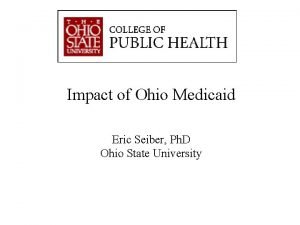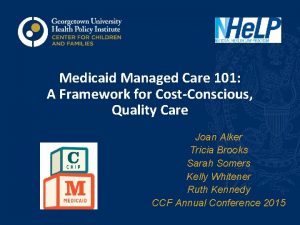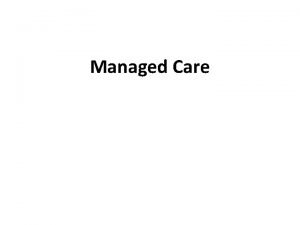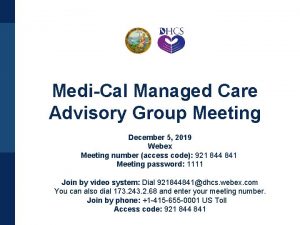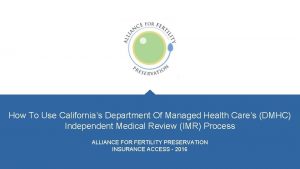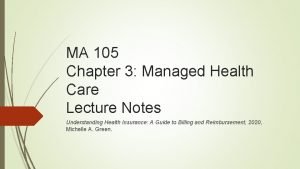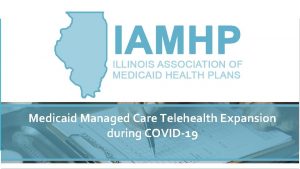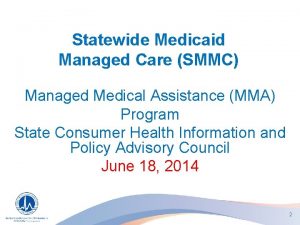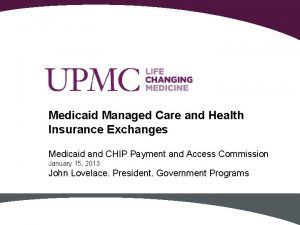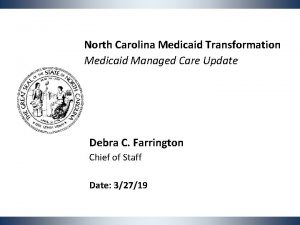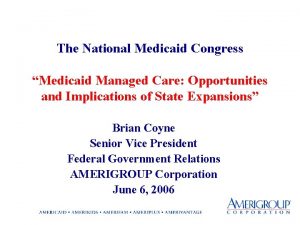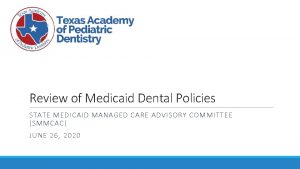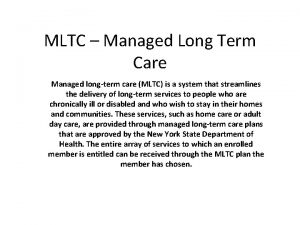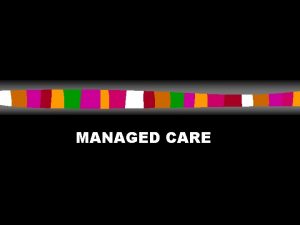Medicaid Managed Care in Ohio June 29 2018

















- Slides: 17

Medicaid Managed Care in Ohio June 29, 2018 Angela Weaver, OAHP Director of Regulatory Affairs Holly Saelens, Molina Healthcare Vice President, Government Contracts Toni Fortson-Bigby, Care. Source Director, Regulatory & Consumer Advocacy

OAHP Overview Who We Are: The Ohio Association of Health Plans (OAHP) represents 15 member plans providing health insurance coverage to more than 9 million Ohioans. Ohio’s health plans include carriers providing coverage in both the private and public markets. Core Mission: To promote and advocate for quality health care and access to a variety of affordable health benefits for all Ohioans

Managed Care is Reshaping Ohio Medicaid Managed care was first introduced into the Ohio Medicaid program in the late 1970 s. Managed care plans are leveraging best practices and innovations to help Ohio Medicaid improve care quality and reduce overall cost. MCPs provide Ohio’s Medicaid program with the ability to modernize care delivery and improve health outcomes through care coordination, value-added services, and partnerships with providers and communities. MCPs are incentivized to control costs and improve quality through innovative initiatives.

Fee-for-Service vs. Managed Care Historically, Fee-for-Service (FFS) has been the common approach taken by state Medicaid programs. • In a Fee-for-Service model, health care services are paid for as individual units of service; every type of service has a pre-defined rate. • This is an a la carte approach that emphasizes quantity of care over quality. Today, many states – including Ohio – are embracing a Managed Care model of health care delivery. • Under such models, a state Medicaid program contracts with private managed care plans (MCPs) to provide health care coverage to beneficiaries. The state then pays an MCP a per member per month/capitation payment.

Fee-for-Service vs. Managed Care More than 85% of Ohio’s Medicaid population is insured through six managed care plans. *Aetna is a sixth plan serving the dual beneficiary population (My. Care Ohio) Just 10 years ago, only 30% of Medicaid consumers were afforded the benefits of managed care.

Medicaid Managed Care Following a procurement process, Ohio moved to a new managed care model in July 2013. The current program reduces fragmentation and ensures that all Medicaid managed care plans are available statewide. Care quality and access standards are key components to Ohio’s Medicaid managed care model.

Eligible Populations Medicaid Managed Care The majority of Ohio’s Medicaid population is required to participate in managed care. • Children and families • Adult Extension • Aged, Blind and Disabled (ABD) adults and children • Children in custody or receiving adoption assistance • Children receiving services through the Bureau for Children with Medical Handicaps (BCMH) • Breast and Cervical Cancer Project enrollees • Individuals on a Developmental Disabilities waiver * However, some populations that are excluded from that ODM’s managed care program: • Individuals on home and community-based services waivers o Members eligible through expansion are eligible to receive HCBS waiver services o My. Care Ohio demonstration beneficiaries are eligible to receive HCBS waiver services • Individuals who are institutionalized • Individuals who are eligible for both Medicaid and Medicare o Except beneficiaries living in My. Care Ohio demonstration counties *optional enrollment

Medicaid Managed Care Ohio Revised Code Chapter 5167 and Ohio Administrative Code Chapter 5061 -26 contains laws and rules regulating Medicaid managed care plans. Medicaid MCPs are also held to requirements contained in the Ohio Department of Medicaid’s Provider Agreement. This ensures that Ohio continues to benefit from the partnership. Requirements include: • Quality measures and standards to evaluate plan performance in key program areas such as access, clinical quality and consumer satisfaction. • MCPs must ensure adequate access is available to members for all required provider types. • Plans must convene a Managed Care Plan Family Advisory Council at least quarterly in each region that the plan serves consisting of the MCP’s current members. • Sets requirements for MCPs to guard against fraud, waste, and abuse.

Medicaid Managed Care plans must cover all services that are included as under the state’s FFS program. • • • Inpatient hospital services Outpatient hospital services Physician services Lab and X-ray services Screening, diagnosis, and treatment services for children under 21 years (Healthchek/EPSDT) Immunizations Family planning services and supplies Home health and private duty nursing Podiatry Chiropractic Services Physical, occupational, development and speech therapy services • • • Nurse midwife, certified family nurse practitioner, and certified practitioner services Prescription drugs Ambulance and ambulette services Dental services Durable medical equipment and medical supplies Vision care services Nursing facility services Hospice care Behavioral health services Respite services for eligible children receiving Supplemental Security Income (SSI) Medicaid Managed Care plans may also provide enhanced services that are not available under the standard Fee-for-Service program. Services may include: • • • Additional Transportation Benefits Incentive Programs Self-Service Capabilities • Disease Management and Health Education Programs • Enhanced Dental and Vision Programs • Extended Provider Office Hours

Medicaid Managed Care My. Care Ohio In addition to the standard Medicaid Managed Care Program, Ohio launched the My. Care Ohio demonstration program in 2014. • Time-limited program running through 2019. My. Care Ohio provides coordinated benefits to individuals enrolled in both Medicaid and Medicare. • Historically, there has been little to no coordination between state Medicaid programs and the federal Medicare program • The dual-eligible population commonly has complex health care needs that require high-cost services. The program is ‘live’ in seven geographical regions composed of 29 Ohio counties. Ohio was among the first states to adopt a managed care approach to care for this population.

Medicaid Managed Care Capitation Payments Each Medicaid MCP receives a monthly capitation payment from the state. These payments are made in exchange for covering beneficiaries’ health care needs. All capitation rates are required to be actuarially sound, per federal regulations. • Rates are updated annually and reviewed mid-year. • ODM sets rates at the lowest quartile. Under ODM’s Managed Care Program, MCPs are at-risk for service costs exceeding the capitation payment. • In turn, this incentivizes the plans to provide coordinated care to its members that result in positive health outcomes for individuals.

Medicaid Managed Care Management • All Medicaid managed care plans must implement a care management program through a model of care that broadly defines the way services will be delivered to meet population needs. • A well-designed population health management program is driven by clinical, financial, and operational data from internal departments and larger delivery systems providing actionable data that can be used to improve quality of care, patient experience, health equity and cost of care. • Such programs allow plans to better address the immediate needs of members and to partner with the providers to deliver valuable health care services to individuals.

Medicaid Managed Care Key Care Management Requirements • The MCP must develop a risk stratification level framework for the purpose of targeting interventions and allocating resources based on the member’s needs. • The MCPs must assess new members using a standardized health risk assessment within 90 days of enrollment for the purpose of risk stratification and to identify potential needs for care management. • The MCP must ensure members are able to access care management services when needed. • The MCP must develop and implement safeguards, systems, and processes that detect, prevent, and mitigate harm and/or risk factors that could impact an individual’s health, welfare, and safety. When the MCP identifies or becomes aware of risk factors, it shall put in place services and supports to mitigate and address the identified issues as expeditiously as the situation warrants.

Managed Care Plan Performance ODM Managed Care Plans Report Card In 2015, the Ohio Department of Medicaid established an annual Managed Care Plans Report Card to assist consumers in choosing a plan that best fits their needs. • Another source of accountability and transparency. The Report Card uses a 3 -star rating system and utilizes data from a series of reporting sources. Five reporting categories: • Keeping Kids Healthy • Getting Care • Doctors’ Communication & Services • Living with Illness • Women’s Health

Managed Care in Ohio Today Cost Savings through Managed Care Plans rely on evidence-based practices and market innovations to improve Ohio’s health care delivery system. Ø This leads to greater efficiency and improved health outcomes. The Department of Medicaid incentivizes the Medicaid managed care plans to lower health care costs through strategies that promote preventive care services and care coordination for members with complex conditions. The department also holds MCPs accountable for improving population health outcomes and enhancing provider network management. Ø All of this is needed to foster a sustainable Medicaid program for the future. These strategies assist plans and the State of Ohio to achieve programmatic savings by Ø promoting the efficient use of the health care system; Ø eliminating wasteful spending by placing an emphasis on preventative care, care coordination to manage chronic conditions, the detection and treatment of serious illnesses early; Ø and partnering with providers to improve quality outcomes.

Managed Care in Ohio Today Cost Savings through Managed Care Released in February 2017, The Impact of Private Industry on Public Health Care report illustrates the cost savings that managed care has brought to Ohio Medicaid in recent years. The Wakely Consulting Group conducted an evaluation of Ohio’s Medicaid’s programmatic savings 2013 – 2015. The report compares MCP capitation rates to the estimated costs that would have been incurred had those same members been covered by the traditional fee-for-service program during that time. Wakely estimated that the capitation rates paid to the MCPs were 8. 9 percent ($2. 5 B) to 11. 3 percent ($3. 2 B) lower in the period from CY 2013 through CY 2015 than the estimated costs had ODM served those same members in the FFS program.

Cost Savings – Managed Care to Fee-for-Service Estimated Savings Relative to Fee for Service Based on Assumed Trend Differential (CY 2013 – 2015) Estimated FFS Costs $27, 741, 384, 000 Calculated MCO Revenue (1) $25, 282, 492, 000 Total Dollars Saved Total Percentage Saved $2, 458, 892, 000 8. 9% Based on 0. 5% Annual Trend Differential (CY 2013 – 2015) Theoretical FFS Costs $28, 491, 486, 000 Calculated MCO Revenue (1) $25, 282, 492, 000 Total Dollars Saved Total Percentage Saved $3, 208, 994, 000 11. 3% (1) Excludes Health Insuring Corporation Tax and Sales & Use Tax Source: Ohio Medicaid Managed Care Savings Analysis – January 2013 through December 2015 http: //oahp. org/wp-content/uploads/2017/02/Wakely_OH-Medicaid-2013 -15 -Managed-Care-Savings-Analysis_20170120. pdf
 Wyoming medicaid portal
Wyoming medicaid portal Ohio medicaid eapg
Ohio medicaid eapg Ohio medicaid insurance
Ohio medicaid insurance June 2019 geometry regents answers
June 2019 geometry regents answers June 2015 flacs exam answers
June 2015 flacs exam answers Cxccxc results 2018
Cxccxc results 2018 Spanish flacs exam 2018 answers
Spanish flacs exam 2018 answers Chemistry january 2018 answers
Chemistry january 2018 answers Managed care 101
Managed care 101 Ppo managed care
Ppo managed care Nathan nau dhcs
Nathan nau dhcs Department of managed health care california
Department of managed health care california Managed care 101
Managed care 101 Managed care is categorized according to six models
Managed care is categorized according to six models Cea registry
Cea registry Care continuum prior authorization
Care continuum prior authorization Gina stinson
Gina stinson History of managed care
History of managed care

